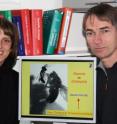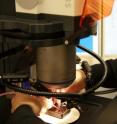Genome of parasitic wasps released
Related images
(click to enlarge)
(Jena) When fully grown they have a diminutive size of only 1-2 mm: the "Nasonia" wasps. But great hopes are drawn from them. Nasonia are parasitic insects infesting fly pupae. By doing so, they are naturally eliminating important agricultural pests. In order to provide constant supply of food for its offspring, the wasp must prevent the early death of the host flies – not less then 40-50 eggs are laid into each pupa. As biological pest control Nasonia is not yet perfect. But this could be changed in the future by using genetic engineering since the whole genome of Nasonia has been decoded by an international team of researchers supported by zoologists from Jena University. Their findings will be published in this Friday's issue of the well renowned journal „Science" (15/01/2010). "We now have the fully elaborated genome of Nasonia at our disposal," says Dr. Reinhard Predel from the Friedrich-Schiller-University Jena, pleased about it. Nasonia has long been known for its useful way of life. The wasp also became interesting for sciencists because its cells tend to contain their own 'parasitoid' "Wolbachia" bacteria. The international team of researchers – lead by the US-American Prof. Dr. John H. Werren – has detected that these bacteria perform a strong lateral gene transfer with their host cells. That is why bacteria genes can also be found in the wasp genome, which made the analysis of the genome „quite difficult," as Reinhard Predel can confirm. Finally the complete elimination of the bacteria by antibiotics confirmed the existence of an extensive transfer of genes.
The Jena zoologist and his colleague, Dr. Susanne Neupert, were not involved in the decoding process itself. After having been invited to the international team for preparing the ground very well, their contribution was the verification of the geneticists assumptions. If, for instance, the geneticists gave a prediction that a certain gene was responsible for the production of hormones, the neuropeptide experts in Jena faced the difficult experimental task to prove or to reject these assumptions.
"We take a look inside the animals to see if the predicted end products exist," Predel simplifies a long-drawn-out process which needs not only scientific expertise but also craftsmanship. "The concentration of hormones and transmitters is very low in this animal," explains Susanne Neupert. In order to carry out mass-spectrometric investigations, the Jena scientists had to take hormone-producing cell groups from the tiny wasp's brain – a preparation between heartbeats since "the miniaturization is extreme", Predel confirms. In spite of frustrating moments – "we did not really like this insect," admits Predel – they were successful within a years time. Excellent mass spectra could be produced. Due to the Jena analyses, numerous neuropeptides could be identified and possible functions in behaviourial control could be postulated.
"With this work, the genomes of the first parasitoid insects were classified," Reinhard Predel says happily about this pioneering performance. Nasonia belongs to the more than 100.000 parasitoid wasp species that could potentially be useful for humankind. In order to genetically optimize the useful tiny insect and to better understand the biology of Nasonia, "we have to sequence a few more related species," Predel points out to future tasks. They will focus on the detection of genes which are particularly important for the parasitic way of life. The start has been made – as the current issue of "Science" as well as the detailed accompanying publications show.
Source: Friedrich-Schiller-Universität Jena
Articles on the same topic
- Parasitic wasps' newly sequenced genomes reveal new avenues for pest controlFri, 15 Jan 2010, 15:26:18 UTC
- Genome advances peril for pestsThu, 14 Jan 2010, 22:25:50 UTC
- Genome sequences for wasps will aid pest and disease control, provide new model organismThu, 14 Jan 2010, 19:27:56 UTC
- Parasitic wasps' genomes provides new insights into pest control, geneticsThu, 14 Jan 2010, 19:27:48 UTC
- Sequencing wasp genome sheds new light on sexual parasiteThu, 14 Jan 2010, 19:27:43 UTC
Other sources
- Wasp genome could aid pest controlfrom UPIMon, 18 Jan 2010, 22:21:30 UTC
- Wasp genome holds targetsfrom Science AlertSun, 17 Jan 2010, 12:56:10 UTC
- Sequencing wasp genome sheds new light on sexual parasitefrom Science DailySat, 16 Jan 2010, 1:14:18 UTC
- Swarms of Engineered Voodoo Wasps Will Seek and Destroy Crop Pestsfrom PopSciFri, 15 Jan 2010, 16:42:14 UTC
- Genome advances peril for pestsfrom Science BlogFri, 15 Jan 2010, 3:42:09 UTC
- Genome advances peril for pestsfrom Science BlogThu, 14 Jan 2010, 23:35:19 UTC
- Genome of parasitic wasps releasedfrom Biology News NetThu, 14 Jan 2010, 23:21:16 UTC
- Parasitic wasps' genomes provides new insights into pest control, geneticsfrom Science DailyThu, 14 Jan 2010, 22:28:05 UTC
- Sequencing Wasp Genome Sheds New Light on Common Sexual Parasitefrom Newswise - ScinewsThu, 14 Jan 2010, 19:35:13 UTC
- Parasitic wasps' genomes provides new insights into pest control, genetics (w/ Video)from PhysorgThu, 14 Jan 2010, 19:14:35 UTC
- Scientists decode genome of helpful waspsfrom CBC: Technology & ScienceThu, 14 Jan 2010, 19:14:20 UTC

